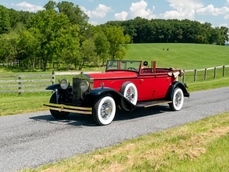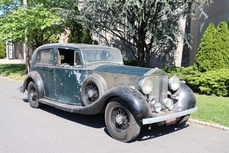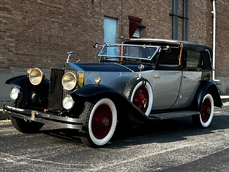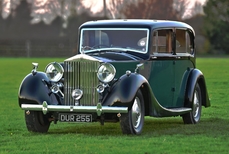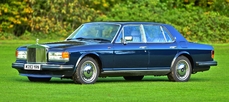Rolls-Royce Phantom II I Four Light Cabriolet Coachwork by Freestone & Webb 1938
Allgemeine Beschreibung :
Vintage and Prestige are proud to offer this 1938 Rolls-Royce Phantom III Four Light Cabriolet Coachwork by Freestone & Webb For Sale.
Chassis no: 3 DL 94
Engine no: Q88N
Design no: 1971
Body no: 1317
Registration: FKN 1
Mileage shown: 35,0147,338cc OHV aluminium V12 engine165bhp at 3,000rpm4-speed manual gearboxIndependent front suspension with coil springs, semi-elliptic springs rear 4-wheel-brakes servo assistedUnique coachworkOnly centre gearshift Phantom III built Perhaps the most outstanding luxury car of the 1930s - certainly to have been built in the United Kingdom - was the Rolls-Royce Phantom III. Introduced in 1936, the 7,340cc V12-engined Phantom III succeeded the Phantom II, the six-cylinder engine of which was considered to be at the end of its development life. The choice of a V12 configuration was a logical one for Rolls-Royce, the company already having had considerable experience of manufacturing V12 aero engines such as that used in the record-breaking Supermarine S6B seaplane. No doubt another consideration was the need to match the multi-cylinder opposition, notably the V16 Cadillac and V12 Hispano-Suiza. A state-of-the-art design employing advanced materials and techniques such as 'skeleton' cylinder blocks with wet liners and aluminum alloy cylinder heads, the PIII V12 produced 165bhp in its debut form. The maximum output was subsequently raised to 180 brake horsepower, which was sufficient to propel later examples to 100mph, earlier models being capable of around 90. Its engine configuration aside, the Phantom III represents an important milestone in the history of Rolls-Royce cars, being the first with independent front suspension. A total of 727 had been manufactured when WW2 halted production, of which around 300 exist worldwide today. By the late 1930s, coachbuilding design had evolved considerably from the 'Roaring Twenties' days, and there were far fewer open sporting bodies built at all on Rolls-Royce automobiles. Gone were the days of lavish spartan 'Torpedos' that were built on the first two series of Phantom chassis. The fashion was slightly more austere and inclined toward two door 'Drophead Coupes' which offered fully open or fully enclosed road conditions, and were more orientated to the owner-driver market. At the top end, luxury cars were still fully coachbuilt operations though, and the buyer of a Rolls-Royce was certainly in a position to decide precisely how their car would look and for what purpose it would be built, and a few of those clientele commissioned full 'all weather' bodies on the V12 Phantom III chassis. The numbers built were certainly modest at the time, and survivors such as this are even fewer. Among its higher brow and rare brethren, this is by any standards a rare automobile. It was ordered new by K.L. Bilbrough of Chislehurst in Kent, in the U.K., a wealthy gentleman who was by then the Chairman of the shipping and marine insurance business his father had founded in 1862. The story goes that its unique creation reflected Mr. Bilbrough's previous penchant for driving Packard motorcars, but when he elected to change for the latest model, he discovered to his dismay that the new car would not fit in his garage!
At this point, two domestic companies took over the mantel, Rolls-Royce and Freestone and Webb. Stipulating that the car must not exceed 17 feet, 7 inches, even with its bumpers fitted, the coachwork was designed. Other intriguing specifics were required, in order to match the central gear-change lever that he was used to in his Packard, the Rolls-Royce was built in this way also, it being the sole example of this model so equipped. White faced instruments were required with black numerals and bezels, and they were to be on a dash panel rather than in the standard cluster. No clock was fitted, nor a Spirit of Ecstasy hood ornament either. Further, he required that it be registered for the road with a license plate that he wouldn't forget, that number was 'FKN1', and when it was delivered to him it must have its odometer zeroed.
There were a number of slightly dated aspects to the order, such as the fitment of a bulb horn when electric horns were of course then the norm, and a four piece windshield which harked back to 1920s coachwork styles more than current traits. Freestone and Webb's design drawings and photos taken in period by Chas. Bowers confirm that the car was very much completed as specified. In fact it must have made quite an impression as Autocar featured the finished Phantom in their magazine in July 1939. It can also be safely assumed that Mr. Bilbrough was happy with his purchase as he would retain it for more than 23 years, in fact until his death in 1962, at the considerable age of 90. At this point the Rolls was sold by his estate, having covered a little under 34,000 miles in its lifetime. The next owner again kept the car until his passing in 2007, a lengthy 45 years of custodianship, at this point the ownership passed to his son. The son retained ownership for another 7 years, a cumulative ownership of 52 years within the same family.
This unique Phantom III must have had one of the simplest lives of any of these cars and for the most part remains highly original in detail and true to the form in which it was delivered new, save for a repaint to its fenders and re-upholstery of its seating areas, but never receiving a full restoration. Its mileage remains extremely low, particularly for these motors, at only 35,014 miles. In more recent times it has been sympathetically maintained by marque experts. She is running smoothly and driving beautifully.
In our showroom ready for viewing.
1938 Rolls-Royce Phantom II I Four Light Cabriolet Coachwork by Freestone & Webb is listed zu verkaufen on ClassicDigest in Essex by Prestige House for Preis nicht verfügbar.
Fakten der Auto
Karosserietyp : Auto Marke : Rolls-Royce Modell : Phantom II Ausführung : I Four Light Cabriolet Coachwork by Freestone & Webb Hubraum : 0.0 Modelljahr : 1938 Karosstyp : Convertible Lage : Essex Fahrzeug Anmeldung : Undefiniert
Preis nicht verfügbar
Angaben Zum Verkäufer
Vintage & Prestige
Prestige House
+44(0)1375 379719, +44(0)7967 260673
Prestige House
+44(0)1375 379719, +44(0)7967 260673
People who viewed this Rolls-Royce Phantom II also viewed similar Rolls-Royce listed at ClassicDigest
Other cars listed for sale by this dealer
über Rolls-Royce
Nun, meine Damen und Herren, heute tauchen wir ein in die glanzvolle Geschichte einer Marke, die immer das ganz Wesen britischen Luxus und Handwerkskunst verkörpert hat - Rolls-Royce.Unsere Geschichte beginnt zu Beginn des 20. Jahrhunderts, als zwei Visionäre, Charles Rolls und Henry Royce, beschlossen, sich zusammenzuschließen. Im Jahr 1904 wurde der allererste Rolls-Royce geboren, der Rolls-Royce 10 hp. Es war ein bescheidener Anfang für ein Unternehmen, das die Automobil-Exzellenz neu definieren würde.
Aber es war erst 1907, dass Rolls-Royce wirklich seinen Stempel aufdrückte, mit der Einführung des Silver Ghost. Er wurde als das "Beste Auto der Welt" gefeiert und setzte den Goldstandard für Luxusautos. Mit seinem flüsterleisen Motor und seiner exquisiten Handwerkskunst war er ein Statement von Opulenz und Raffinesse.
Die 1920er Jahre brachten uns den Rolls-Royce Phantom I, ein Ikone seiner Zeit. Es war der erste Rolls-Royce mit einem 6-Zylinder-Motor und legte den Grundstein für die legendäre Phantom-Reihe. Dies war die Ära, in der die Maharadschas von Indien maßgefertigte Rolls-Royces in Auftrag gaben, die nichts weniger als automobilen Palästen entsprachen.
Schnell vorwärts in die Nachkriegsjahre, und wir haben den Silver Cloud, ein Symbol für den britischen Optimismus der Nachkriegszeit. Der Silver Cloud verkörperte Eleganz, mit seinen fließenden Linien und handgefertigten Interieurs. Er war die Wahl von Königen, Prominenten und Industriekapitänen.
Aber wenn wir über das Epizentrum des Rolls-Royce-Luxus sprechen, dann ist es der Rolls-Royce Phantom VI, der uns von 1968 bis 1991 begleitete. Dies war ein Auto, das die Aussage traf, dass "wenn Sie nach dem Preis fragen müssen, können Sie es sich nicht leisten." Anpassung war das Stichwort, und der Phantom VI war eine Leinwand für die weltweit Wohlhabendsten, um ihren einzigartigen Geschmack auszudrücken.
Nun, es ist unmöglich, über Rolls-Royce zu sprechen, ohne den Rolls-Royce Corniche zu erwähnen. Produziert von 1971 bis 1995, handelte es sich um eine Cabriolet- und Coupé-Version des Silver Shadow. Der Corniche war der Inbegriff des Grand Touring, ein Auto für diejenigen, die den Kontinent in absolutem Luxus durchqueren wollten.
Aber, ach, selbst die Mächtigsten müssen ihren Niedergang erleben, und Rolls-Royce war keine Ausnahme. Das Unternehmen durchlief in den 1970er und 80er Jahren finanzielle Turbulenzen, was zur Übernahme durch Vickers plc führte. Dann kam die umstrittene Eigentümerschaft von BMW und Volkswagen, die die Enthusiasten spaltete.
Rolls-Royce erlangte unter BMW-Besitz wieder Boden, und das neue Jahrtausend brachte uns den Rolls-Royce Phantom VII, eine Rückkehr zu den Wurzeln des Unternehmens für kompromisslosen Luxus. Der Phantom VII war ein Zeugnis für britische Ingenieurskunst und Handwerkskunst.
Und das, meine Damen und Herren, bringt uns auf den heutigen Tag. Rolls-Royce produziert weiterhin einige der opulentesten, maßgeschneiderten Fahrzeuge auf dem Planeten, ein Symbol für die britische Imperium, das mit der Zeit nicht verblasst ist. Der Geist von Sir Henry Royce und Charles Rolls lebt in jedem Auto weiter, das die Spirit of Ecstasy trägt, ein Zeugnis für das anhaltende Erbe der britischen Automobil-Exzellenz.
















